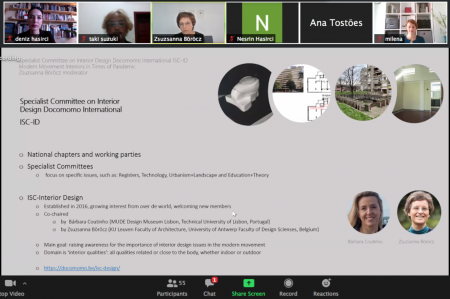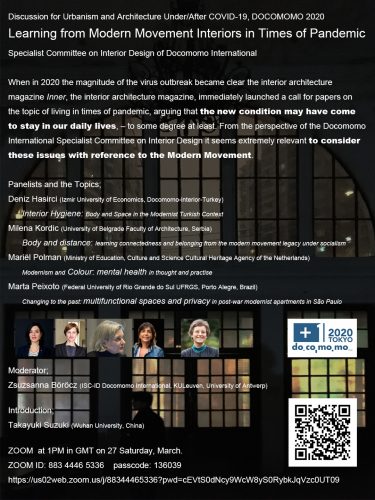Learning from Modern Movement Interiors in Times of Pandemic.
A little souvenir from the 3rd Contribution to the open discussion Modernism Frozen 2020+1 which was organized on Modern Movement Interiors in Times of Pandemic by the Specialist Committee on Interior Design Docomomo International. We have received a lot of positive feedback so we are happy to tell you that we had a successful event. We would like to thank all contributors for their efforts in making this happen.
All of the presentations were very rich and informative. Congratulations to all speakers: Deniz Hasirci, Milena Kordić, Mariël Polman and Marta Peixoto. We hope to continue the discussion, especially because we can see that there are several commonalities although the topics we focused on were quite varied.
Zsuzsanna Böröcz and Bárbara Coutinho (co-chairs of the ISC-ID)
Re-watch the debate on Youtube:


—
ONLINE DISCUSSION | Sat. 27 March 2021, 13h00 | Zoom
Contribution to the open discussion Modernism Frozen. Urbanism and Architecture under/after Covid-19
Learning from Modern Movement Interiors in Times of Pandemic.
by the Specialist Committee on Interior Design of Docomomo International
Join the online discussion at Zoom (registration not required):
https://us02web.zoom.us/j/88344465336?pwd=cEVtS0dNcy9WcW8yS0RybkJqVzc0UT09
ID: 883 4446 5336
Passcode: 136039
(download here poster as pdf)
When in 2020 the magnitude of the virus outbreak became clear the interior architecture magazine Inner: the interior architecture magazine immediately launched a call for papers on the topic of living in times of pandemic, arguing that the new condition may have come to stay in our daily lives, – to some degree at least. According to Inner, a number of themes concerning this new condition and its relation to interiors therefore needs to be examined: space and multifunctionality, smart working, new duties such as home schooling and fitness, outdoor activities entering the home, the challenges of the smart interior, and how the public interior reacts to social distancing1. From the perspective of the Docomomo International Specialist Committee on Interior Design it seems extremely relevant to consider these issues with reference to the Modern Movement. We thereby propose to focus on ‘interior qualities’ in the sense of all qualities related or close to the body – whether indoor or outdoor –, thus avoiding the narrow interpretation of the interior.
Panelists and Topics:
– Deniz Hasirci (Izmir University of Economics, Docomomo-interior-Turkey):
Interior Hygiene: Body and Space in the Modernist Turkish Context
– Milena Kordic (University of Belgrade Faculty of Architecture, Serbia)
Body and distance: learning connectedness and belonging from the modern movement legacy under socialism
– Mariël Polman (Ministry of Education, Culture and Science Cultural Heritage Agency of the Netherlands)
Modernism and Colour: mental health in thought and practice
– Marta Peixoto (Federal University of Rio Grande do Sul UFRGS, Porto Alegre, Brazil)
Changing to the past: multifunctional spaces and privacy in post-war modernist apartments in Sao Paulo
Moderator: Zsuzsanna Böröcz (ISC-ID Docomomo International, KULeuven, University of Antwerp)
Introduction: Takayuki Suzuki (Wuhan University, China)
We would like to refer to historian Paul Overy’s 2008 book Light, Air and Openness, and in particular its opening chapter entitled ‘Health’. The volume, which deals with Zeitgeist aspects that deeply influenced Modernism such as notions on hygiene and purity but also on the bond between democracy and economy, touches on preoccupations which seem to return in the current Covid era. Zooming in from the city to the house, the author describes the challenges of hygiene and cleanliness in a way which strikingly reflects our present concerns. The modernists’ pervasive obsession with hygiene and cleanliness on a personal, domestic and urban level recall the lessons that people around the world have recently been forced to (re)learn: how and how long to wash hands, how to greet, how to quarantine an infected family member in one’s home, to more complex questions such as how to organise hospitals and care homes. The parallels run even deeper: the recent calls for a new and better society triggered by the pandemic, involving more equitable societal organisation principles, show many similarities with the modernist ethos.
This reflection raises many questions. What can the legacy of the Modern Movement teach us about living in health and hygiene? How relevant are its views on related issues such as the degree of connectedness or separation between the private and the public, or between the built and the natural environment? Can ideas such as the machine à habiter or the Existenz Minimum provide clues for new, more virus-resistant typologies, which, with the aid of technology, flexibly adapt the boundaries between the private, collective and public spheres, preventing excesses of distance and solitude, and enhancing solidarity? Can concerns for objectivity, the truthful treatment of functions, or an architecture designed around the scale, movement and perception of the human body help give place to the personal, the human and the poetic within a framework aimed at control, purification and biosecurity? How can these topics influence newbuild and re-use design processes?
The recent Docomomo Journal, which foresightedly centred on ‘Cure and Care’, takes a specific perspective to related issues ‘of health and healthcare facilities, entering the realm of “hygiene” with the goal of debating the process of modernization as a medical procedure’2. One of Docomomo’s great strengths is that it is founded on scientific research of Modernism’s theoretic foundations as well as of its practices, its tangible legacy and its most appropriate conservation techniques. This heritage was born from the interplay between what was thought and written and what was built and crafted. We must remember this in handling its conservation and its legacy. The hygienic ideal of ‘smooth shiny surfaces’3 should never prevent us from discovering and preserving the fragile materials that were actually used. Neither should materials detract us from the complex and multi-layered ideas behind them: a healthy mind in a healthy body, a sober interior to minimise dust and the need for dusting, machines to lighten labour and increase efficiency, the creation of conditions for leisure and personal development.
These idea(l)s and the search for ways to achieve them are as current, challenging and essential as ever. Not only in relation to the private home, care homes or hospitals, but to our entire environment, everywhere.
With this call and the subtitle Learning from Modern Movement Interiors in Times of Pandemic the ISC-ID would like to contribute to the open discussion Modernism Frozen. Urbanism and Architecture under/after Covid-19, launched by the organisation of the Docomomo International Conference 2020+1, in order to develop it into one of the themes which will take place in September 2021 in Tokyo.
Zsuzsanna Böröcz, Mariël Polman, Eva Storgaard, Els De Vos




